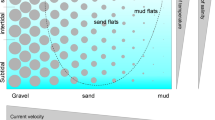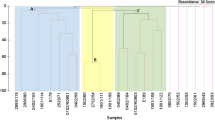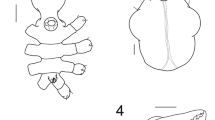Abstract
The Bellingshausen and Amundsen Seas are among the least studied Antarctic areas. Pycnogonids constitute a common and conspicuous component of the Antarctic marine fauna. Antarctic pycnogonids have been widely studied and are usually more abundant than elsewhere. Therefore, they represent a key taxon to understand the zoogeographic and bathymetric distributions of the fauna from these two poorly sampled seas. Furthermore, we aim to compare the diversity and composition of the pycnogonids in these areas with those in other Antarctic zones. Three main surveys were carried out in these regions (Bentart 2003 and 2006 and Biopearl II 2008). In total, 879 pycnogonids belonging to 65 species were recorded in 49 stations. Two new species are described: Heteronymphon krappi n.sp. and Nymphon nakamurai n.sp. Ammothea magniceps and A. hesperidensis are recorded for the second time in the Antarctic. The most abundant family is the Nymphonidae (60.5 %), and Nymphon australe is the most abundant species (25.5 %). The biogeographic analysis revealed 39 species in the Bellingshausen Sea (16 new records) and 19 species in the Amundsen Sea (18 new records). The circumpolar pattern is the most common found. The Bellingshausen Sea seems to be a poor area in terms of abundance and species richness compared to the Amundsen Sea and other Antarctic zones. Faunal similarity was clustered into three main groups: the shallow-water stations, the outer continental shelf stations and the slope stations. The abundance of individuals likely responds to the varying amount of organic matter that reaches each bathymetric zone.






Similar content being viewed by others
References
Ameneiro J, Mouriño-Carballido B, Parapar J, Vázquez E (2012) Abundance and distribution of invertebrate larvae in the Bellingshausen Sea (West Antarctica). Polar Biol 35:1359–1373
Arango CP, Soler-Membrives A, Miller KJ (2011) Genetic differentiation in the circum—Antarctic sea spider Nymphon australe (Pycnogonida; Nymphonidae). Deep Sea Res II 58:212–219
Arntz WE, Gutt J, Klages M (1997) Antarctic marine biodiversity: an overview. In: Battaglia B, Valencia J, Walton DW (eds) Antarctic marine communities: species, structure and survival. Cambridge University Press, Massachussetts, pp 3–14
Arrigo KR, van Dijken GL (2003) Phytoplankton dynamics within 37 Antarctic coastal polynya systems. J Geophys Res Oceans 108:3271
Arrigo KR, Lowry KE, van Dijken GL (2012) Annual changes in sea ice and phytoplankton in polynyas of the Amundsen Sea, Antarctica. Deep Sea Res II 71–76:5–15
Bamber R (2011) The sea-spiders (Arthropoda: Pycnogonida) of Admiralty Bay, King George Island. Pol Polar Res 32:27–38
Barker PF, Burrell J (1977) The opening of Drake Passage. Mar Geol 25:15–34
Bouvier EL (1913) Pycnogonides du “Pourquoi-Pas?”. Deuxième expédition antarctique française (1908–1910) 6:1–169
Brandt A et al (2007) The biodiversity of the deep Southern Ocean benthos. Philos Trans R Soc B B Sci 362:39–66
Bray JR, Curtis JT (1957) An ordination of the upland forest communities of Southern Wisconsin. Ecol Monogr 27:325–349
Cano E, López-González P (2013) Two new species of Ammothea (Pycnogonida, Ammotheidae) from Antarctic waters. Helgol Mar Res 67:337–347
Child CA (1995a) Antarctic and Subantarctic Pycnogonida III. The family Nymphonidae. Biology of Antarctic Seas XXIII. Antarct Res Ser 69:1–68
Child CA (1995b) Antarctic and Subantarctic Pycnogonida IV. The families Colossendeidae and Rhynchothoraxidae. Biology of Antarctic Seas XXIII. Antarct Res Ser 69:69–111
Child CA (1998) The Marine Fauna of New Zealand: pycnogonida (Sea Spiders). NIWA Biodivers Mem 109:1–71
Clarke A, Crame JA (1989) The origin of the Southern Ocean marine fauna. Geological Society, London, Special Publications 47:253–268
Clarke A, Johnston N (2003) Antarctic Marine Benthic Diversity. Oceanogr Mar Biol Annu Rev 41:47–114
Clarke KR, Warwick RM (2001) A further biodiversity index applicable to species lists: variation in taxonomic distinctness. Mar Ecol Prog Ser 216:265–278
Corbera J, San Vicente C, Sorbe JC (2009) Cumaceans (Crustacea) from the Bellingshausen Sea and off the western Antarctic Peninsula: a deep-water link with fauna of the surrounding oceans. Polar Biol 32:611–622
Dietz L, Krapp F, Hendrickx M, Arango C, Krabbe K, Spaak J, Leese F (2013) Evidence from morphological and genetic data confirms that Colossendeis tenera Hilton, 1943 (Arthropoda: Pycnogonida), does not belong to the Colossendeis megalonyx Hoek, 1881 complex. Org Divers Evol 13:151–162
Eastman JT, Grande L (1989) Evolution of the Antarctic fish fauna with emphasis on the recent notothenioids. Geol Soc Lond Spec Publ 47:241–252
Fry WG, Hedgpeth JW (1969) Pycnogonida, 1: colossendeidae, Pycnogonidae, Endeidae, Ammotheidae. Fauna of the Ross Sea, 7. NZ Oceanogr Inst Mem 198:1–139
Gili JM et al (2006) A unique assemblage of epibenthic sessile suspension feeders with archaic features in the high-Antarctic. Deep Sea Res II 53:1029–1052
Giltay L (1935) Pycnogonides. In: Résultats du voyage de la Belgica en 1897–1899 (Expédition antarctique belge). Rapports scientifiques. Bruxelles, pp 1–16
Gordon I (1932) Re-description of some type-specimens of pycnogonids of the genus Nymphon. Ann Mag Nat History (10) 9:97–120
Griffiths HJ (2010) Antarctic marine biodiversity—what do we know about the distribution of life in the Southern Ocean? PLoS ONE 5:e11683
Griffiths HJ, Barnes DKA, Linse K (2009) Towards a generalized biogeography of the Southern Ocean benthos. J Biogeogr 36:162–177
Griffiths HJ, Arango CP, Munilla T, McInnes SJ (2011) Biodiversity and biogeography of Southern Ocean pycnogonids. Ecography 34:616–627
Hedgpeth JW (1969) Pycnogonida. In: Distribution of selected groups of marine invertebrates in waters south of 35°S latitude. Antarctic Map Folio Series, Folio 11:26–28
Kaiser S, Barnes DA, Sands C, Brandt A (2009) Biodiversity of an unknown Antarctic Sea: assessing isopod richness and abundance in the first benthic survey of the Amundsen continental shelf. Mar Biodivers 39:27–43
Krabbe K, Leese F, Mayer C, Tollrian R, Held C (2010) Cryptic mitochondrial lineages in the widespread pycnogonid Colossendeis megalonyx Hoek, 1881 from Antarctic and Subantarctic waters. Polar Biol 33:281–292
Linse K, Griffiths HJ, Barnes DKA, Clarke A (2006) Biodiversity and biogeography of Antarctic and sub-Antarctic mollusca. Deep Sea Res II 53:985–1008
Linse K et al (2013) The macro- and megabenthic fauna on the continental shelf of the eastern Amundsen Sea, Antarctica. Cont Shelf Res 68:80–90
Livermore R, Nankivell A, Eagles G, Morris P (2005) Paleogene opening of Drake Passage. Earth Planet Sci Lett 236:459–470
Mahon AR, Arango CP, Halanych KM (2008) Genetic diversity of Nymphon (Arthropoda: Pycnogonida: Nymphonidae) along the Antarctic Peninsula with a focus on Nymphon australe Hodgson 1902. Mar Biol 155:315–323
Matallanas J, Olaso I (2007) Fishes of the Bellingshausen Sea and Peter I Island. Polar Biol 30:333–341
Mills MM, Alderkamp AC, Thuróczy CE, van Dijken GL, Laan P, de Baar HJW, Arrigo KR (2012) Phytoplankton biomass and pigment responses to Fe amendments in the Pine Island and Amundsen polynyas. Deep Sea Res II 71–76:61–76
Müller HG (1993) World catalogue and bibliography of the recent Pycnogonida. Wissenschaftlicher Verlag HG, Wetzlar
Munilla T (2000) A new species of Ammothea (Pycnogonida) and other pycnogonids from Livingston Island and surrounding waters (South Shetland Islands, Antarctica). Antarct Sci 13:144–149
Munilla T (2001) Synopsis of the pycnogonids from Antarctic and Subantarctic waters. Polar Biol 24:941–945
Munilla T, Soler-Membrives A (2009) Check-list of the pycnogonids from Antarctic and sub-Antarctic waters: zoogeographic implications. Antarct Sci 21:99–111
Nakamura K (1985) A new species of pycnogonid, Heteronymphon horikoshii, from the waters adjacent to Honshu, Japan. Bull Biogeogr Soc Japan 40:31–34
Nielsen J, Lavery S, Lörz A-N (2009) Synopsis of a new collection of sea spiders (Arthropoda: Pycnogonida) from the Ross Sea, Antarctica. Polar Biol 32:1147–1155
Peña Cantero Á (2012) Filling biodiversity gaps: benthic hydroids from the Bellingshausen Sea (Antarctica). Polar Biol 35:851–865
Pushkin AF (1993) The Pycnogonida fauna of the South Ocean. Biological results of the Soviet Antarctic Expeditions. Explorations of the fauna of the seas XX (XXX). Biol Res Sov Antarct Exped 8:1–398
San Vicente C, Ramos A, Jimeno A, Sorbe JC (1997) Suprabenthic assemblages from South Shetland Islands and Bransfield Strait (Antarctica): preliminary observations on faunistical composition, bathymetric and near-bottom distribution. Polar Biol 18:415–422
San Vicente C, Munilla T, Corbera J, Sorbe J, Ramos A (2009) Suprabenthic fauna from the Bellingshausen Sea and western Antarctic Peninsula: spatial distribution and community structure. Sci Mar 73:357–368
Soler-Membrives A, Turpaeva E, Munilla T (2009) Pycnogonids of the Eastern Weddell Sea (Antarctica), with remarks on their bathymetric distribution. Polar Biol 32:1389–1397
Thatje S, Arntz W (2004) Antarctic reptant decapods: more than a myth? Polar Biol 27:195–201
Troncoso JS, Aldea C, Arnaud P, Ramos A, García F (2007) Quantitative analysis of soft-bottom molluscs in the Bellingshausen Sea and around Peter I Island. Polar Res 26:126–134
Turpaeva EP, Yampolsky AD (1992) Variability of the eurybathic pycnogonid, Heteronymphon profundum (Pycnogonida, Nymphonidae) from the north-western Pacific Ocean. Zool Zh 71:32–38
Weis A, Friedrich S, Melzer RR (2011) Antarctic Pycnogonida housed at the Bavarian State Collection of Zoology. Zoosyst Evol 87:297–317
Acknowledgments
The BENTART cruises were performed under the auspices of two Spanish Ministry of Science and Technology (MCYT) Antarctic programs (REN2001-1074/ANT and CGL2004-01856). We express our gratitude to the head of campaign Ana Ramos, to the officers and crew of the RV Hespérides and to our colleagues from the BENTART cruises in 2003 and 2006 for their help in this paper. Likewise, we are grateful to Dr. Barnes (BAS) who kindly provided us samples from the British cruise, to Drs. K. Linse and P. Enderlein for organizing and running the BIOPEARL II cruise and to the officers and crew of RRS James Clark Ross, whose patience, accuracy and timing have made this work possible. We also acknowledge the British Antarctic Survey and the Natural Environment Research Council for funding the British expedition. We thank the reviewers for their valuable comments which helped to considerably improve the quality of the manuscript.
Author information
Authors and Affiliations
Corresponding author
Electronic supplementary material
Below is the link to the electronic supplementary material.
Rights and permissions
About this article
Cite this article
Munilla, T., Soler-Membrives, A. Pycnogonida from the Bellingshausen and Amundsen seas: taxonomy and biodiversity. Polar Biol 38, 413–430 (2015). https://doi.org/10.1007/s00300-014-1585-8
Received:
Revised:
Accepted:
Published:
Issue Date:
DOI: https://doi.org/10.1007/s00300-014-1585-8




